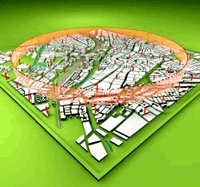Pilot project 7: Aquifer Thermal Energy Storage
Problem

The problem of the subsoil of Utrecht is that several contaminants from different sources have been mixed over the years. In total, 180 million m3 groundwater has been polluted with VOCs. Due to the combination of contaminants, a single case approach is impossible. The total area of the polluted subsoil is approximately 700 Ha. The total area of redevelopment within Utrecht is 90 Ha and is mainly developed by closed and historical buildings with wooden floors etc.
Location
In the Utrecht central station area, the deeper groundwater will be remediated by a combination of ATES (Aquifer Thermal Heat Storage) and biological natural attenuation. This perfect opportunity for synergy between redevelopment, groundwater remediation, and energy storage (reduction of CO2) has resulted in an area-oriented approach.
Aim
The proposal has been made to set up an ATES location to determine the impact of ATES on contamination. The transport and degradation of the contamination will be measured around a new ATES system at this test location using different methods. Firstly, the impact of ATES on contamination can be determined and, secondly, monitoring can be optimised.
The contamination concentration and the bacterial population will be measured regularly in the sources in order to follow degradation in time. A more practical approach is to equip the sources with passive samplers that measure the average contamination concentration during the injection stage. The (average) concentration difference can be determined by equipping the sources with new samplers during the extraction stage, making it possible to determine the degradation rate too. Isotope analysis will be used to distinguish between concentration change caused by degradation and that caused by dilution.
The impact of ATES on the redox condition in the water-carrying layer will be determined by installing observation wells with filters at different depths and sampling these regularly or by equipping them with passive samplers. The spread of heat/cold can also be determined if fibreglass cables are also installed when installing these observation wells.
Results
- CityChlor Think-Tank Conceptual site model - Bio-washing machine;
- Integration of results CSM ‘Bio-washing machine' - Different innovative characterization methods and models for optimisation of the area-oriented approach;
- The combination of aquifer thermal energy storage (ATES) and groundwater remediation, 2012-04-20;
- Video - Bio-washing machine in Utrecht
- Dutch Film: Utrecht - Beste Duurzaamheidsproject

